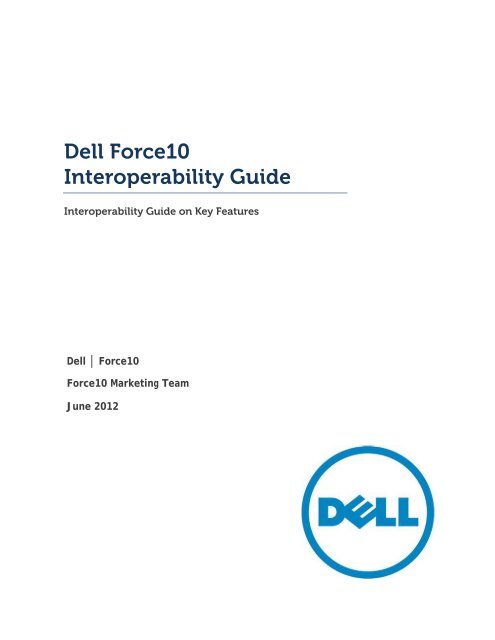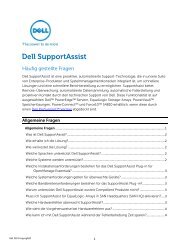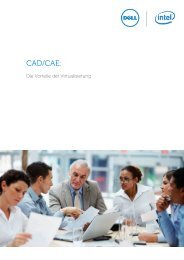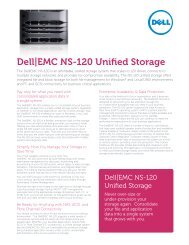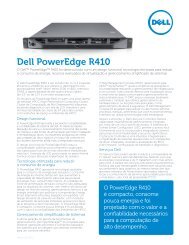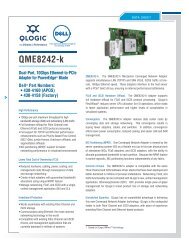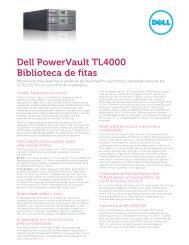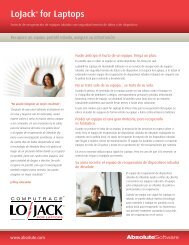Dell Force10 Interoperability Guide
Dell Force10 Interoperability Guide
Dell Force10 Interoperability Guide
You also want an ePaper? Increase the reach of your titles
YUMPU automatically turns print PDFs into web optimized ePapers that Google loves.
<strong>Dell</strong> <strong>Force10</strong><br />
<strong>Interoperability</strong> <strong>Guide</strong><br />
<strong>Interoperability</strong> <strong>Guide</strong> on Key Features<br />
<strong>Dell</strong> │ <strong>Force10</strong><br />
<strong>Force10</strong> Marketing Team<br />
June 2012
<strong>Dell</strong> Networking<br />
THIS WHITE PAPER IS FOR INFORMATIONAL PURPOSES ONLY, AND MAY CONTAIN TYPOGRAPHICAL<br />
ERRORS AND TECHNICAL INACCURACIES. THE CONTENT IS PROVIDED AS IS, WITHOUT EXPRESS<br />
OR IMPLIED WARRANTIES OF ANY KIND.<br />
© 2010 <strong>Dell</strong> Inc. All rights reserved. Reproduction of this material in any manner whatsoever without<br />
the express written permission of <strong>Dell</strong> Inc. is strictly forbidden. For more information, contact <strong>Dell</strong>.<br />
<strong>Dell</strong>, the DELL logo, and the DELL badge, PowerConnect, and PowerVault are trademarks of <strong>Dell</strong> Inc.<br />
Symantec and the SYMANTEC logo are trademarks or registered trademarks of Symantec Corporation<br />
or its affiliates in the US and other countries. Microsoft, Windows, Windows Server, and Active<br />
Directory are either trademarks or registered trademarks of Microsoft Corporation in the United States<br />
and/or other countries. Other trademarks and trade names may be used in this document to refer to<br />
either the entities claiming the marks and names or their products. <strong>Dell</strong> Inc. disclaims any proprietary<br />
interest in trademarks and trade names other than its own.<br />
June 2012<br />
Page ii
<strong>Dell</strong> Networking<br />
Page iii
<strong>Dell</strong> Networking<br />
Contents<br />
Introduction .................................................................................................................................................................... 2<br />
Purpose of This Document ......................................................................................................................................... 2<br />
VTP .................................................................................................................................................................................... 3<br />
Spanning Tree Protocols ............................................................................................................................................. 4<br />
PVST (FTOS) and PVST+ (IOS) ............................................................................................................................. 5<br />
Switch Configuration ........................................................................................................................................... 6<br />
Convergence Test: ................................................................................................................................................ 7<br />
Results: ..................................................................................................................................................................... 7<br />
Results: ..................................................................................................................................................................... 7<br />
RSTP and RPVST+ .................................................................................................................................................. 7<br />
Switch Configuration ........................................................................................................................................... 8<br />
Convergence Test: ............................................................................................................................................... 9<br />
Results: .................................................................................................................................................................. 10<br />
Results: .................................................................................................................................................................. 10<br />
MSTP ...................................................................................................................................................................... 10<br />
Implementation Note ............................................................................................................................................. 11<br />
Miscellaneous ....................................................................................................................................................... 11<br />
Port Channels ............................................................................................................................................................... 11<br />
Figures<br />
Figure 1 : VTP Basic Test Setup ............................................................................ 3<br />
Figure 2: Port Channel FTOS Screenshot ............................................................... 4<br />
Figure 3 : <strong>Dell</strong> Force 10 and Cisco Catalyst 6509 PVST+ Test Setup ............................... 5<br />
Figure 4 : RSTP and PVST+ Setup......................................................................... 8<br />
Figure 5 : S4810_1 Configuration ......................................................................... 8<br />
Figure 6 : S4810_2 Configuration ........................................................................ 9<br />
Figure 7 : Catalyst 6509 Configuration .................................................................. 9<br />
Figure 8 : Port Channel Setup ............................................................................ 11<br />
Figure 9 : Port Channel Configuration .................................................................. 12<br />
Tables<br />
Table 1 : <strong>Dell</strong> Force 10 vs. Cisco Features<br />
Page 1
<strong>Dell</strong> Networking<br />
Introduction<br />
Vendors influence network architectures through features and functionality found in the equipment<br />
they manufacture, leading to the overall look and feel of the network. For example, some vendordriven<br />
networks require a 3-tier model with core, distribution and access. Although this has been the<br />
prevalent design in the past 10 years or so, the overall increase in capex and opex expenses due to the<br />
number of switches at network layer has remained on par. Such design deserves another look.<br />
The proprietary nature of the protocols and features locked customers to one particular vendor, with<br />
some forced interdependencies of some features. Customers were forced to use proprietary features<br />
by the vendor-created dependencies between protocols. For example, early Cisco IP phones rely on<br />
CDP to collect network information and use a Cisco-proprietary PoE standard, not the IEEE standard.<br />
The <strong>Dell</strong> <strong>Force10</strong> philosophy always has bucked this approach. Instead, buy less and build best-ofbreed<br />
open and converged networks has been the model. <strong>Force10</strong> allows for a 2-tier model of<br />
core/distribution and access. Less equipment means lower capex and opex expenses as well as a<br />
lower number of networking points of failure. Customers can design their networks with standardsbased<br />
protocols and features without the need to worry about whether features will be disabled /<br />
unsupported. We have the confidence to allow our customers to build interoperable, multi-vendor<br />
networks based on standards. Inter-dependent features are based on standards. Customers can<br />
change features/products without worrying about changing their network design or architecture.<br />
Purpose of This Document<br />
The purpose of this document is to help <strong>Dell</strong> <strong>Force10</strong> SEs and customers integrate <strong>Dell</strong> <strong>Force10</strong><br />
equipment into legacy Cisco networks.<br />
Table 1 : <strong>Dell</strong> Force 10 vs. Cisco Features<br />
Cisco Proprietary<br />
Feature<br />
<strong>Dell</strong> <strong>Force10</strong><br />
Feature<br />
Standard<br />
Available? Notes<br />
PVST+, RPVST PVST No Full interoperability<br />
CDP LLDP<br />
VTP GVRP<br />
ISL 802.1Q<br />
VMPS<br />
802.1X + Mac-<br />
Auth Bypass**<br />
IEEE<br />
802.1AB<br />
IEEE<br />
802.1p<br />
IEEE<br />
802.1D<br />
Extension<br />
of IEEE<br />
802.1X<br />
Higher scalability & extensibility with LLDP<br />
Extensible - built on top of GARP<br />
ISL has greater header overhead<br />
Cisco supports 802.1X + Mac-Auth-Bypass<br />
extension<br />
Page 2
<strong>Dell</strong> Networking<br />
CGMP IGMP<br />
EIGRP OSPF Yes<br />
PAgP LACP<br />
RFC 1112,<br />
2236<br />
IEEE<br />
802.3ad<br />
Cisco supports IGMP on all platforms<br />
<strong>Force10</strong> recommends OSPF<br />
Cisco also supports OSPF<br />
Cisco supports LACP<br />
HSRP VRRP RFC 2238 Cisco supports VRRP<br />
Netflow sFlow RFC 3176 More scalable<br />
Cisco POE IEEE 802.3af<br />
VTP<br />
IEEE<br />
802.3af<br />
Cisco switches and new IP phones support<br />
the IEEE standard<br />
<strong>Force10</strong> systems can operate in VTP transparent mode, passing traffic on untagged VLANs. Thus,<br />
<strong>Force10</strong> systems can co-exist with VTP-enabled networks. <strong>Force10</strong> recommends deploying the<br />
standards-based GVRP protocol.<br />
VTP packets are passed untagged. Therefore, depending on the configuration, the FTOS native VLAN<br />
or portmode hybrid capability may be required to pass such packets. The portmode hybrid command<br />
sets a physical port or port-channel to accept both tagged and untagged frames.<br />
FTOS Release 7.7.1.0 introduces native VLAN capability on physical interfaces, and FTOS Release<br />
8.2.1.0 extends this to port-channel interfaces. In other words, starting with these releases, FTOS<br />
transparently bridges VTP packets over physical and port-channel interfaces, allowing VTP to run<br />
between devices connected to an FTOS switch/router.<br />
Figure 1 : VTP Basic Test Setup<br />
Page 3
<strong>Dell</strong> Networking<br />
In this sample configuration, port-channel 1 and port-channel 2 are added to VLAN 100 as tagged,<br />
while remaining in VLAN 1 as untagged. Untagged traffic arrives at port-channel 1 and is flooded out<br />
Gigabit Ethernet interface 6/47 or port-channel 2.<br />
Figure 2: Port Channel FTOS Screenshot<br />
interface Port-channel 1<br />
no ip address<br />
portmode hybrid<br />
switchport<br />
channel-member GigabitEthernet 6/0<br />
no shutdown<br />
!<br />
interface Port-channel 2<br />
no ip address<br />
portmode hybrid<br />
switchport<br />
channel-member GigabitEthernet 6/47<br />
no shutdown<br />
!<br />
interface vlan 100<br />
tagged port-channel 1-2<br />
E-Series#show vlan<br />
FTOS Configuration<br />
Codes: * - Default VLAN, G - GVRP VLANs, P - Primary, C - Community, I - Isolated<br />
Q: U - Untagged, T – Tagged x - Dot1x untagged, X - Dot1x tagged G - GVRP tagged, M - Vlan-stack<br />
NUM Status Description Q Ports<br />
* 1 Active U Po1(Gi 6/0)<br />
U Po2(Gi 6/47)<br />
100 Active T Po1(Gi 6/0)<br />
T Po2(Gi 6/47)<br />
Spanning Tree Protocols<br />
<strong>Dell</strong> Force 10 switches running FTOS support the different standard based spanning tree flavors such<br />
as MSTP, RSTP, and PVST. These three different spanning tree variations are fully compatible with<br />
other proprietary spanning tree extensions such as MST, PVST+, and RPVST+<br />
The following section is divided into several scenarios:<br />
• PVST (FTOS) and PVST+ (IOS)<br />
• PVST (FTOS) and RPVST (IOS)<br />
• RSTP and RPVST+<br />
• MSTP<br />
In our next revision, we aim to have two Catalyst 6509’s acting as root and backup root with dual<br />
homed connections from the S4810’s. For now, the results obtained using the configuration on figure<br />
Page 4
<strong>Dell</strong> Networking<br />
3, are clear enough to give us an idea of how the different spanning tree modes interact with each<br />
other.<br />
PVST (FTOS) and PVST+ (IOS)<br />
<strong>Dell</strong> Force 10’s PVST’s implementation is fully compatible with Cisco’s IOS implementation. The<br />
following setup will demonstrate how PVST can be deployed in a mixed environment.<br />
In figure 3, we have a typical deployment where all devices are connected and potentially create a<br />
loop if spanning tree was not configured. The Cisco Catalyst 6509 is the root bridge<br />
Figure 3 : <strong>Dell</strong> Force 10 and Cisco Catalyst 6509 PVST+ Test Setup<br />
PVST is enabled on the <strong>Dell</strong> Force 10 switches, whereas PVST+ is enabled on the Cisco switch. PVST is<br />
the IEEE nomenclature, and PVST+ is Cisco’s equivalent to the IEEE’s PVST version.<br />
Page 5
<strong>Dell</strong> Networking<br />
Switch Configuration<br />
Figure 4 : S4810_1/2 Configuration<br />
Figure 5 : S4810_1/2 PVST Configuration<br />
In S4810_2, port 0/46 is blocking in an alternate role. The alternate role will switch to forwarding as<br />
soon as the local root port fails.<br />
All other ports are forwarding with the Cisco switch acting as the root switch for vlan 10. See figure 6.<br />
Page 6
<strong>Dell</strong> Networking<br />
Figure 6 : Catalyst 6509 Configuration PVST+<br />
Convergence Test:<br />
1. Shutdown link between S4810_2 (Te0/47) and Catalyst 6509 (Te1/1).<br />
Results:<br />
IXIA traffic resumes in less than 2 seconds on link 0/46 on S4810_2. The blocking port moves to the<br />
forwarding state as expected. This is because no interaction is needed with another switch, i.e. no<br />
BPDU exchanged is needed.<br />
2. Restore previous shutdown link between the S4810_2 and the Cisco Cat 6509.<br />
Results:<br />
IXIA traffic resumes 30 seconds later. This is as expected since the link between the S4810_2 and the<br />
Cisco Catalyst 6509 go through the “listening” and “learning” states before moving onto the<br />
“forwarding” state. Each state lasts 15 seconds and thus the 30 second traffic loss.<br />
Note: PVST (FTOS) and RPVST+ (IOS) configuration was also tested and the results were identical to<br />
that of PVST (FTOS) and PVST+ (IOS).<br />
RSTP and RPVST+<br />
Using the same test setup, RSTP and RPVST+ were enabled on the respective switches. For this<br />
particular configuration, port 0/47 on S4810_2 assumes the alternate role and discarding status after<br />
spanning tree settles down.<br />
Page 7
<strong>Dell</strong> Networking<br />
Figure 7 : RSTP and PVST+ Setup<br />
The same set of tests was performed and the results were as expected.<br />
Switch Configuration<br />
Figure 8 : S4810_1 Configuration<br />
Page 8
<strong>Dell</strong> Networking<br />
Figure 9 : S4810_2 Configuration<br />
Figure 10 : Catalyst 6509 Configuration<br />
Convergence Test:<br />
1. Shutdown link Te0/46 on S4810_2 and Te0/47 should take over with minimal traffic interruption.<br />
Te0/47 is in discarding state as an alternate port to the root switch.<br />
Page 9
<strong>Dell</strong> Networking<br />
Results:<br />
As per the IEEE 802.1w standard, the alternate port took over as the root port transitioning from<br />
discarding to learning and forwarding in less than 2 seconds.<br />
2. Bring back port 0/46 and verify 0/47 goes back to being an alternate port role and discarding<br />
state. Traffic should resume very quickly in less than 2 seconds.<br />
Results:<br />
Previously, with PVST and PVST+, reverting the process did not help in the traffic re-convergence<br />
time. The forwarding port still had to go through the traditional spanning tree steps of listening,<br />
learning and finally forwarding causing a 30 second traffic drop.<br />
With RSTP, this did not take place. As expected, port Te0/47 moved to discarding state and port<br />
Te0/46 transitioned to learning, and then forwarding in less than 2 seconds.<br />
MSTP<br />
MSTP was enabled on all the switches and allowed to converge. Port Te0/47 on S4810_2 is blocking<br />
while Te0/46 on the same switch is forwarding. The same set of tests was performed where port<br />
Te0/46 is shutdown and Te0/47 becomes active and traffic resumes under 2 seconds.<br />
Page 10
<strong>Dell</strong> Networking<br />
Implementation Note<br />
Some non-<strong>Dell</strong> <strong>Force10</strong> systems which have hybrid ports participating in PVST+ transmit two kinds of<br />
BPDUs: an 802.1D BPDU and an untagged PVST+ BPDU. The PVST+ BPDU is sent to perform<br />
consistency checking and to inform all other potential Cisco switches about the native VLAN<br />
configuration. Receiving switches consider only IEEE BPDUs for the native VLAN computations and<br />
ignore the SSTP (Shared Spanning Tree Protocol) BPDUs.<br />
<strong>Force10</strong> systems do not expect either tagged or untagged PVST+ BPDUs on an untagged VLAN so<br />
FTOS places the port in error-disable state by default when it receives this type of frame. This behavior,<br />
while consistent with other vendors, might result in the network not converging.<br />
To resolve this issue, which is documented in PR 84608, FTOS Release 8.2.1.0 introduces a CLI option<br />
to set the error-disable state for receiving PVST BPDUs received on an untagged VLAN.<br />
<strong>Force10</strong> (conf-if-gi-4/0)# spanning-tree pvst err-disable cause invalid-pvst-bpdu<br />
The FTOS default remains placing the port in an error-disable state if a tagged or untagged PVST<br />
BPDU is received on an untagged VLAN.<br />
Note: If VLAN 10 is untagged and an FTOS system receives a PVST BPDU with VLAN tag 20, the BPDU<br />
is simply dropped.<br />
Port Channels<br />
Both FTOS and Cisco IOS support the Link Aggregation Control Protocol (LACP) for exchanging<br />
information required to create a port-channel interface.<br />
Figure 11 : Port Channel Setup<br />
Page 11
<strong>Dell</strong> Networking<br />
Figure 12 : Port Channel Configuration<br />
6509 Configuration C300 Configuration<br />
interface TenGigabitEthernet1/3<br />
switchport<br />
switchport trunk encapsulation dot1q<br />
switchport trunk allowed vlan 10-15,97-99<br />
switchport mode trunk<br />
no ip address<br />
load-interval 30<br />
spanning-tree portfast disable<br />
channel-group 2 mode on<br />
!<br />
interface TenGigabitEthernet1/4<br />
switchport<br />
switchport trunk encapsulation dot1q<br />
switchport trunk allowed vlan 10-15,97-99<br />
switchport mode trunk<br />
no ip address<br />
load-interval 30<br />
spanning-tree portfast disable<br />
channel-group 2 mode on<br />
interface TenGigabitEthernet 0/1<br />
no ip address<br />
no shutdown<br />
!<br />
interface TenGigabitEthernet 1/1<br />
no ip address<br />
no shutdown<br />
!<br />
interface Port-channel 2<br />
description to-6509-Right<br />
no ip address<br />
switchport<br />
spanning-tree pvst vlan 11 cost 200000<br />
channel-member TenGigabitEthernet 0/1<br />
channel-member TenGigabitEthernet 1/1<br />
rate-interval 30<br />
no shutdown<br />
Page 12


